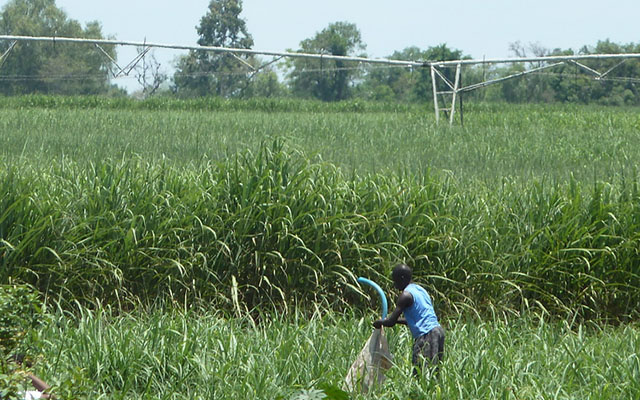
With a target of cutting emissions by about 202 gigatonnes of carbon dioxide equivalent by 2030 through blending petrol with ethanol, a sugarcane-derived fuel, Zimbabwe has made some progress
Jeffrey Gogo Climate Story
Since 2001 when Zimbabwe started to put a price on carbon for fuel, ostensibly to curb greenhouse gas emissions, petrol and diesel consumption has expanded rapidly ever since. For example, between 2009 and 2015, petrol and diesel use – a major source of climate warming gases – climbed nearly 150 percent to 1,38 million litres each year, data from energy regulator ZERA shows, as Zimbabweans bought more cars.
But as earnings from the tax on carbon topped $200 million in the past five years, according to figures from tax collector Zimra, it has become evident the tax was not so much about climate protection as it were for boosting Treasury coffers. There is no clear indication whether revenues from a tax that enforces compliance on motorists against carbon emissions has been distributed in a manner that supports low-carbon development. That’s not to say this can’t still be done. As Zimbabwe participates in the ongoing UN climate talks to end fossil fuels use and limit global temperature rise to 2 degrees Celsius in this Century, the role that carbon tax could play to help achieve the country’s climate goals under the Paris Agreement seem underplayed.
To drive on the roads, Zimbabwean motorists have to pay US3 cents per litre of petrol, and per litre of diesel, for the pollution they cause, Zimra says. That’s about $13 per tonne of carbon dioxide emissions equivalent (CO2e) for petrol, and $11 per tonne of CO2 emissions for diesel, according to calculations by The Herald Business. However, this is substantially lower than what is actually needed to achieve the global temperature targets agreed at Paris in 2015.
To do that, prices would have to rise to between $40/tCO2e – $80/tCO2e, says the World Bank’s State and Trends of Carbon Pricing 2017 report released ahead of the annual climate negotiations, which opened in Germany on November 6. It is unlikely taxes on carbon will rise as much here due to the potentially difficult economic implications. But the pricing of carbon is one of several issues underpinning Zimbabwe’s climate change plans under the Paris Agreement.
According to its Nationally Determined Contributions (NDCs), a set of national pledges to mitigating climate change under the Paris treaty, the country aims to avoid an unspecified amount of emissions by selling carbon earned from maintaining healthy forests. Zimbabwe requires $1 billion to fully implement this project, however, a UN recognised project known as Reducing Emissions from Deforestation and forest Degradation (REDD+) is assisting.
The country has since started to get ready for rolling out REDD+, with a needs assessment already completed, Washington Zhakata, Zimbabwe climate change director, has told the Herald Business. And though the climate plan speaks about reviewing the transport system to the tune of $37 billion, as a mitigatory measure, it is silent on how carbon tax will function towards achieving similar goals in the transport industry, a 1 000 gigatonne carbon dioxide emitting sector.
Ethanol blending
Clearly, carbon tax has not been effective as an emissions-controlling measure in Zimbabwe for the one reason that it has not been used to deliver climate-sensitive interventions. In its early years, the application of the tax didn’t even seem an effective tool for curbing automobile industry emissions, but more a clever design to improve Government revenues. With motorists obliged to pay the tax only on a quarterly or annual basis during the motor vehicle licence renewal payment, the system disregarded the individual’s frequency of travel, which is the frequency of carbon emissions.
That system later on changed into one that forces heavy fuel consumers to pay more for the pollution they cause, and vice-versa. It remains unclear why the carbon tax here is levied at a flat rate for both diesel and petrol, where diesel has a higher emissions potential compared to petrol. On the average, each litre of diesel produces 2,7 kg of CO2 emissions equivalent, and petrol 2,3 kg, scientists say
With over 81 countries to achieve their emission goals by putting a price on carbon, there is, therefore, need to align the taxes on carbon with the Zimbabwe’s climate goals under the Paris Agreement on climate change. But with a target of cutting emissions by about 202 gigatonnes of carbon dioxide equivalent by 2030 through blending petrol with ethanol, a sugarcane-derived fuel, Zimbabwe has made some progress.
The 54 percent decline in petrol imports during the three months to September 30, 2017 indicates the higher levels of ethanol blending, now at 20 percent. There’s no clarity on the amount of greenhouse gas emissions avoided from the blending initiative as yet, but this is undoubtedly easy on the pocket and on climate for Zimbabwe, which, spends about $2 billion each buying fuel abroad.
God is faithful.
